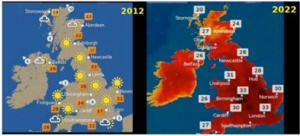What’s going on?
During the last month, we were bombarded with headlines such as:
This month is the planet’s hottest on record by far – and hottest in around 120,000 years, scientists say —CNN, July 27, 2023
July 2023 ‘Virtually Certain’ To Be Hottest Month In Human History —Forbes, July 27, 2023
So is there any validity to these claims… Was July the hottest month in human history? [emphasis, links added]
…snip…
Our civilization’s trajectory, from its humble beginnings in the wild to its current digital sophistication, serves as a testament to humanity’s relentless drive for advancement and ability to adapt.
The African Humid Period (AHP) and the rise of the Egyptian civilization…
The African Humid Period (AHP) is a climatic phase during the Holocene epoch characterized by much wetter conditions in large parts of Africa, especially the Sahara region, compared to the present day.
This significant shift in precipitation patterns had profound impacts on both the environment and early human societies of the continent.
The AHP roughly spanned from about 15,000 to 5,000 years ago, though exact timings can vary based on specific regions within Africa. It began at the end of the Last Glacial Maximum when ice sheets started retreating in the Northern Hemisphere.
One of the most dramatic manifestations of the AHP was the transformation of the Sahara desert. Today’s vast desert expanse was once a mosaic of grasslands, lakes, and rivers.
This “Green Sahara” supported a variety of wildlife, from large mammals like elephants and giraffes to a variety of fish in its waterways.
The wet conditions of the AHP supported a much denser human population in regions that are now desert. Archaeological evidence shows that these ancient Saharan communities engaged in fishing, hunting, cattle herding, and even agriculture.
The abundance of water and food allowed for relatively settled lifestyles compared to the more nomadic existences necessitated by the arid conditions that followed.
The primary driver behind the AHP is believed to be warmer summer temperatures and changes in the monsoon systems, which brought more rain to the African continent.
As these parameters shifted over millennia, the monsoons weakened, leading to the aridification of vast regions.
The African Humid Period serves as a reminder of the profound climatic variability our planet has experienced throughout relatively recent geological history at preindustrial levels of CO2, and the relative insensitivity of surface temperature and/or humidity and the concentration of GHG in the atmosphere.








